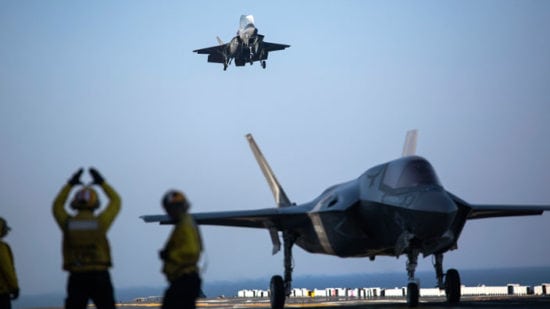
F-35. Photo courtesy of Lockheed Martin
The U.S. Defense Department’s (DoD) fleet of F-35 fifth-generation fighter jets is progressing toward entry into IOT&E, but the fleet will not be ready to meet several of the readiness criteria until late 2018. Robert Behler, DoD’s director of operational test and evaluation outlined progress with the F-35 fleet’s readiness in his recently published 2017 annual report.
According to Behler, all three variants of the F-35 continued flight sciences testing throughout 2017. The F-35A conventional takeoff and landing variant testing was completed in March 2017, with the exception of drag chute testing that must take place in Norway.
Testing on the F-35B short-takeoff-and-vertical-landing variant will not be complete until “early” 2018, Behler noted. The F-35B needs test-unique tail coasting to prevent overheating at “high airspeed test points,” and some engine restrictions have also lead to delays in testing.
On the F-35C carrier variant, testing in 2017 featured the redesigned outboard wing structure, which is “required to support carriage of the AIM-9X air-to-air missile on a pylon,” the report said.
“Overall fleet-wide monthly availability rates remain around 50%, a condition that has existed with no significant improvement since October 2014, despite the increasing number of new aircraft,” Behler wrote.
An increase in the percentage of the fleet that cannot fly has also been attributed to a need for replacement parts that DoD is still awaiting as well. There will also be a need for redesigning some aircraft components in order for the program to achieve DoD’s goal for the number of flight-testing hours.
Behler also highlighted DoD’s need to update its risk-based testing guidance to reflect the agency’s increased dependency on software to enable new capablities in weapons systems, such as those featured on the F-35. This is a major focus area in 2018, he says.
“The F-35 Joint Strike Fighter’s effectiveness in combat relies on software mission data loads, which work in conjunction with the avionics software and hardware to drive sensor search parameters. These files are critical for F-35 identification and correlation of threat and friendly radar signals. This increased dependence of system capabilities on software dictates that T&E must become a continuous, risk-based process for the life cycle of the system,” Behler wrote in the report.
On Jan. 5, 2018, Lockheed Martin published its own program status update for the F-35 program, noting that 265 total F-35s have been delivered to 14 military bases worldwide with 540 pilots and more than 5,000 maintainers. Total program costs for all three variants amount to $338 million, for low-rate initial production (LRIP) 10.